Art tools naturally strengthen weak hands through repetitive movements that enhance neural connections between your brain and muscles. When you grip brushes or manipulate clay, you’re engaging fine motor skills while releasing dopamine and serotonin that boost neuroplasticity. The weighted handles and ergonomic grips distribute pressure evenly, reducing pain while building strength. Both hands benefit through interlimb transfer, even when you only work with one. Discover how artistic expression transforms rehabilitation into an enjoyable, healing journey.
The Science Behind Art Tools in Hand Rehabilitation
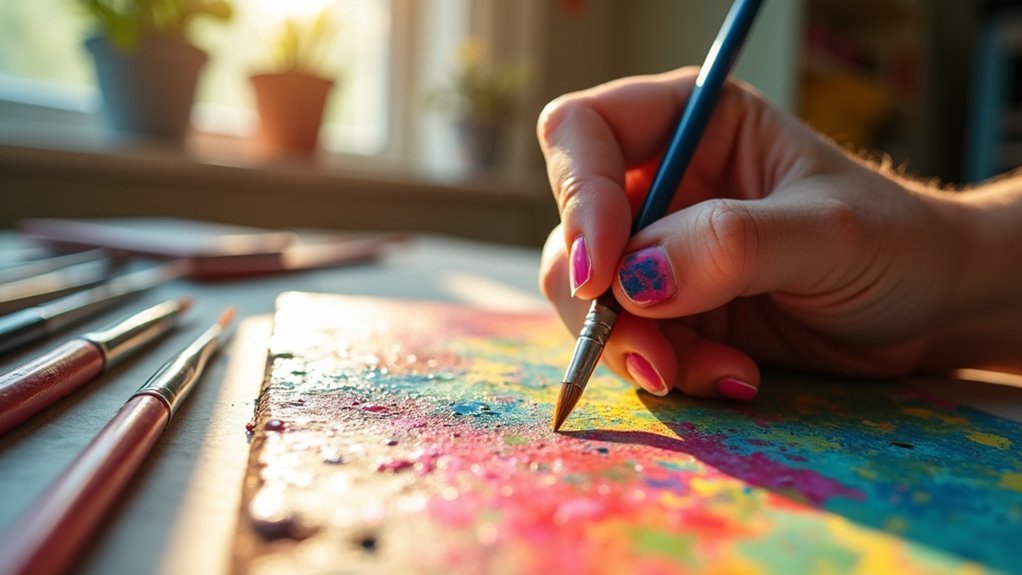
While often overlooked in clinical settings, art tools serve as powerful rehabilitation instruments for individuals with weakened hands. The science supporting this approach is compelling: engaging in artistic activities enhances fine motor skills essential for hand function recovery.
When you paint, draw, or sculpt, you’re activating neural pathways that promote neuroplasticity and motor recovery. Your brain benefits from “interlimb transfer,” where training one arm improves motor functions in both limbs. This process is particularly effective with novel creative tasks.
Beyond physical benefits, art therapy reduces stress and improves self-perception—psychological factors vital to rehabilitation success. Art therapy supports a holistic approach that addresses emotional, somatic, artistic, and spiritual dimensions, serving as an outlet for feelings like anger and frustration. Your active participation in creative activities stimulates muscle engagement and sensory integration, often matching or exceeding conventional therapy’s effectiveness while providing the emotional satisfaction conventional approaches might lack.
Adapting Art Materials for Enhanced Grip Strength
You’ll find weighted art tools can dramatically improve your hand control by engaging larger muscle groups and providing tactile feedback during painting or drawing.
Simple modifications like adding cushioned grips to brushes or pencils can reduce pain while allowing for more extended creative sessions.
These ergonomic adaptations work by distributing pressure more evenly across your hand, preventing strain in specific areas that typically cause discomfort when gripping tools.
For those with inconsistent grip strength, specialized devices like the Easy Writer Clip offer additional support, though currently these are only available for right-handed artists.
Weighted Tool Benefits
Although often overlooked, weighted art tools offer substantial benefits for artists with weak hands.
These specialized implements provide variable resistance that you can adjust as your grip strength improves, targeting both flexor and extensor muscles simultaneously.
You’ll notice improved endurance in your forearm muscles, allowing you to work longer with demanding mediums without fatigue.
The enhanced grip strength gives you better control over precision tools, while the injury prevention benefits reduce your risk of developing tendonitis and other common artistic ailments.
The portability of weighted tools means you can strengthen your hands anywhere. This improved functionality can significantly enhance quality of life by making daily artistic tasks more manageable and efficient.
Ergonomic Grip Modifications
When creating art with weak hands, making strategic modifications to your tools can dramatically improve your comfort and performance. Expanding handle thickness with foam or rubber increases surface area, allowing you to grip with less strain while maintaining control. Properly contoured grips intuitively guide your hand placement, reducing the force needed during art sessions. These modifications often feature anti-slip surfaces to ensure stability during detailed work.
For effective grip improvements:
- Add padding from foam or grip tape to distribute pressure and minimize stress on hand tissues.
- Choose tools designed for power grip (whole hand) rather than pinch grip to reduce finger fatigue.
- Incorporate flute cuts or finger grooves that provide resistance against axial forces.
These modifications support all directions of force encountered during art-making, preventing overexertion while allowing you to express yourself more freely despite hand weakness.
Neuroplasticity Benefits From Artistic Expression
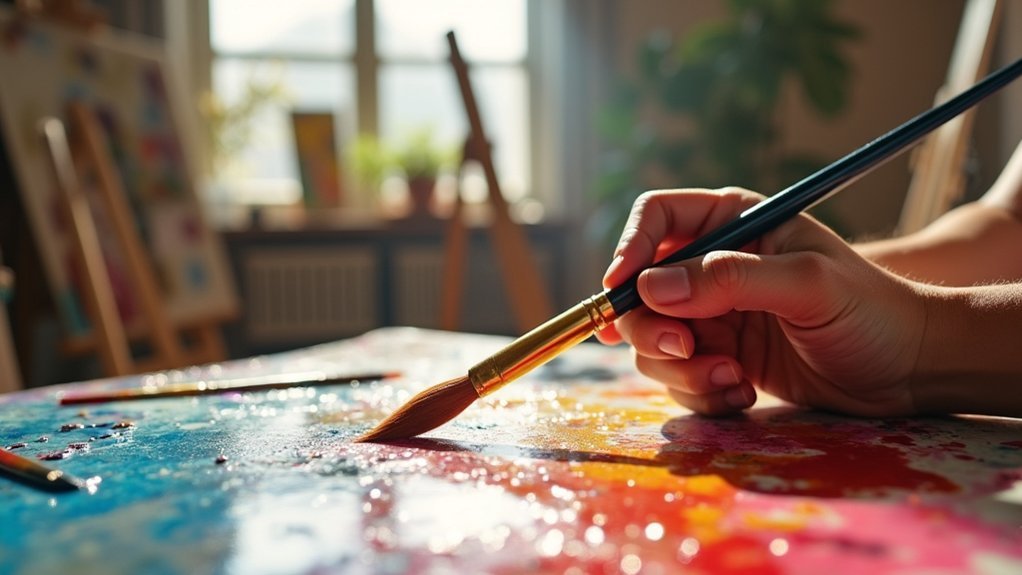
Your artistic practice activates mirror neurons that help your brain relearn movement patterns, particularly important after injury or stroke.
Creating art with both hands encourages bilateral cortical reorganization, allowing healthy brain regions to compensate for weakened areas.
Each artistic motion strengthens the sensorimotor learning loop, where repeated movements reinforce neural pathways between your brain’s motor planning areas and the muscles in your hands. Artistic engagement also triggers the release of dopamine, which influences the strengthening of neural connections in regions associated with motor coordination.
Mirror Neurons Activate Rehabilitation
Since the discovery of mirror neurons, researchers have found remarkable connections between artistic expression and neurological rehabilitation. When you observe and perform artistic hand movements, you’re activating these specialized brain cells that fire both during action and observation, effectively rewiring damaged neural pathways and enhancing recovery.
Art tools create a unique rehabilitation environment by:
- Stimulating mirror neuron systems through combined observation and execution of precise hand movements
- Creating continuous sensory feedback loops that promote synaptic plasticity and cortical reorganization
- Engaging emotional and motivational systems that enhance mirror neuron activity and rehabilitation effectiveness
This neurological mechanism explains why art therapy considerably improves hand function and motor skills, offering both statistical and clinical improvements in patients with weak hands—whether from stroke, injury, or other conditions. The process of learning artistic techniques through observation triggers automatic brain responses that support faster rehabilitation progress, mimicking the natural way humans learn through imitation.
Bilateral Cortical Reorganization
The remarkable plasticity of the human brain allows for significant reorganization when both hemispheres are engaged through artistic expression.
When you create art that requires crossing the midline—like drawing across a page with your weaker hand—you’re actually strengthening the communication between your brain’s hemispheres.
These cross-lateral movements enhance interhemispheric coordination, essential for motor recovery. Activities that promote symmetrical movements, like using both hands to shape clay, simultaneously activate motor cortices on both sides of your brain.
This bilateral engagement helps your brain compensate for damaged areas by creating new neural pathways. Engaging in artistic processes stimulates brain regions associated with emotion, motor function, and memory integration.
Your brain’s adaptability means it can optimize function by redistributing tasks across both hemispheres, effectively creating workarounds for weak hands and improving overall coordination and strength.
Sensorimotor Learning Loop
At the core of our brain’s adaptability is a fascinating process called the sensorimotor learning loop—a continuous cycle where sensory information and motor actions strengthen each other through artistic practice.
When you engage with art materials, your brain receives tactile feedback about texture, pressure, and resistance while simultaneously refining the motor commands to your hands. Trauma can significantly disrupt this vital feedback loop, causing imbalances between sensory perception and motor impulses.
This powerful neurological mechanism supports your recovery through:
- Neural pathway reinforcement – Each artistic session strengthens connections between sensory and motor regions
- Multisensory integration – Art tools engage touch, vision, and proprioception simultaneously
- Emotional facilitation – Creative expression releases dopamine and serotonin, enhancing neuroplasticity
You’ll notice improvements in grip strength, dexterity, and endurance as your brain adapts to these artistic challenges, gradually transferring these gains to everyday activities.
Measuring Improvements in Hand Function Through Art
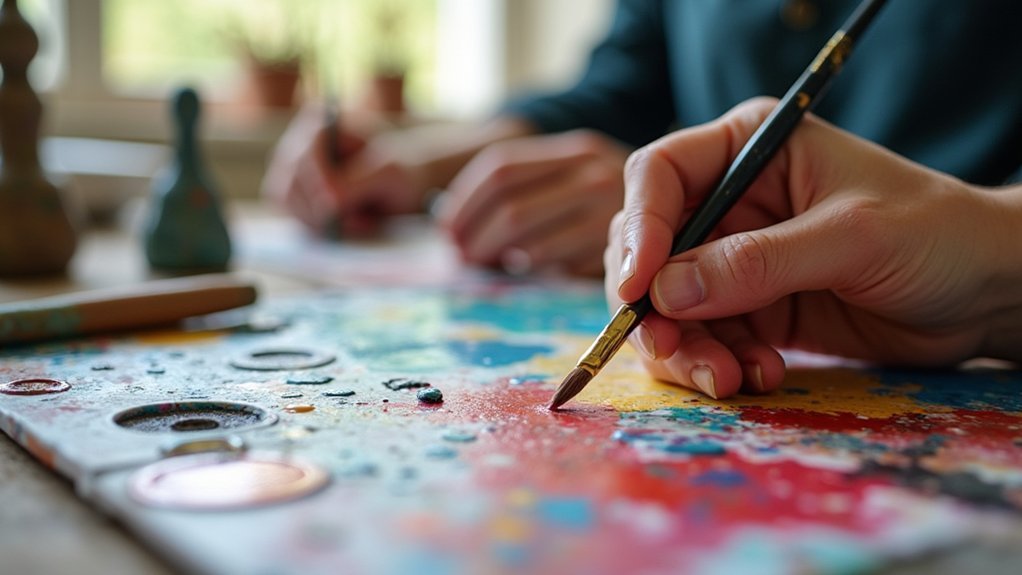
Objective assessment of hand function improvements helps practitioners validate art-based interventions for patients with weak hands. You’ll see measurable gains through standardized tests that track your progress over time.
Grip and pinch strength measurements provide quantifiable evidence of improvement, while functional tests like the Jebsen-Taylor Hand Function Test evaluate real-world capabilities.
For stroke rehabilitation patients, these assessments track upper limb sensorimotor recovery through art therapy.
Quality of life questionnaires including the Michigan Hand Outcome Questionnaire and AUSCAN offer insights into how these improvements affect your daily activities.
With completion rates around 84% and minimal dropout, art-based rehabilitation shows promising adherence. Research indicates art therapy can be as effective as conventional physiotherapy, making it a valuable alternative for strengthening weak hands. Studies across multiple databases show positive impacts on both fine motor abilities and emotional well-being among stroke patients engaging in creative activities.
Complementary Hand Exercises for Artists With Weakness
While creating art provides natural rehabilitation benefits, incorporating specific hand exercises into your routine can dramatically improve dexterity and control when using adaptive art tools.
Art-making heals, but targeted hand exercises can supercharge your dexterity when working with adaptive tools.
Start with gentle warm-ups like finger lifts and OK stretches before your art sessions to prepare your hands for creative work.
For ideal results, combine strengthening and flexibility exercises:
- Squeeze a small rubber ball for 5-10 seconds several times daily to build grip strength needed for holding brushes and tools
- Practice finger spreads between drawing sessions to increase range of motion across your hand
- Perform wrist extension stretches regularly to prevent stiffness and pain during extended art sessions
Remember to take frequent breaks during art-making to stretch and reset your hands, preventing fatigue and strain. Taking short 2-minute breaks every hour to perform finger and thumb exercises is particularly beneficial for maintaining dexterity throughout longer creative sessions.
Psychological Motivation: Creating While Strengthening
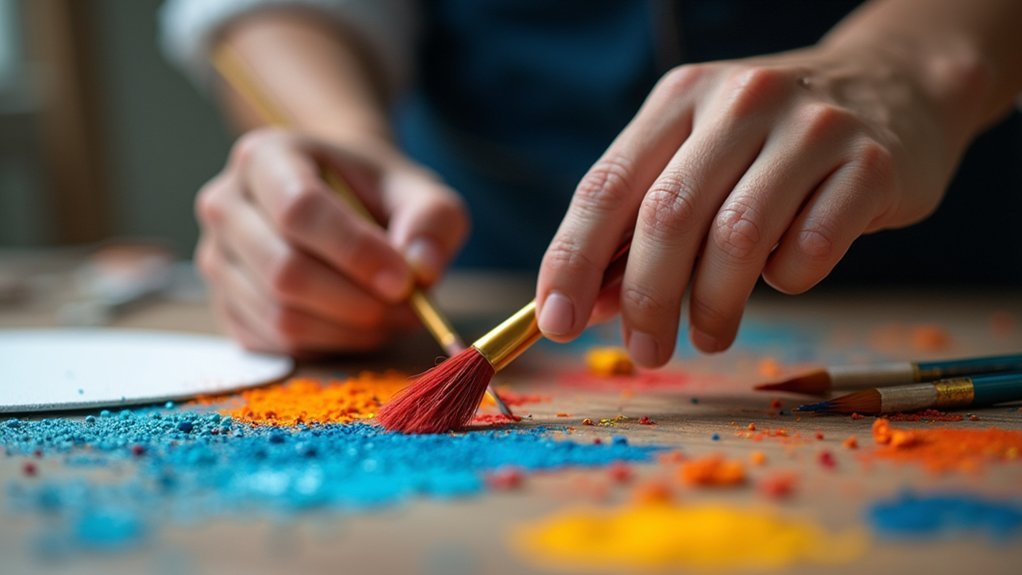
The psychological benefits of creating art extend far beyond the canvas, particularly for artists with hand weakness. When you engage in creative activities, your brain releases dopamine, boosting your motivation while simultaneously strengthening your hands through repetitive movements.
This dual benefit creates a powerful cycle—as you create art, you enter a flow state that diverts attention from discomfort while your hands gain strength. Many artists report that focusing on the process rather than their limitations helps reduce anxiety about their condition.
The sense of accomplishment you feel after completing a project, despite physical challenges, enhances your self-esteem and encourages continued practice. Collaborating with a trained art therapist can help establish specific goals and techniques that maximize both the therapeutic and physical rehabilitation aspects of creative work.
This therapeutic engagement provides both emotional expression and physical rehabilitation, transforming necessary hand exercises into meaningful creative experiences.
Real Success Stories: From Weakness to Artistic Capability
Many individuals who once struggled with hand weakness have transformed their limitations into artistic strengths, proving that physical challenges don’t define creative potential.
These success stories demonstrate how art therapy contributes to both physical recovery and emotional healing.
- John’s journey with Guillain-Barré syndrome shows how consistent artistic practice restored his fine motor control while providing an emotional outlet during recovery.
- Embracing imperfections in artwork helps patients develop self-acceptance, building emotional resilience alongside physical strength.
- The vulnerability expressed through art creates a unique therapeutic environment where holistic rehabilitation flourishes.
Art therapy offers a powerful way to make sense of difficult experiences while building hand strength, as patients engage in creative processes that bring unconscious feelings to conscious awareness.
You’ll find that these real-life transformations highlight art therapy’s dual benefit: measurable improvement in motor function paired with profound emotional processing that traditional physical therapy alone can’t provide.
Choosing the Right Art Tools for Your Hand Condition
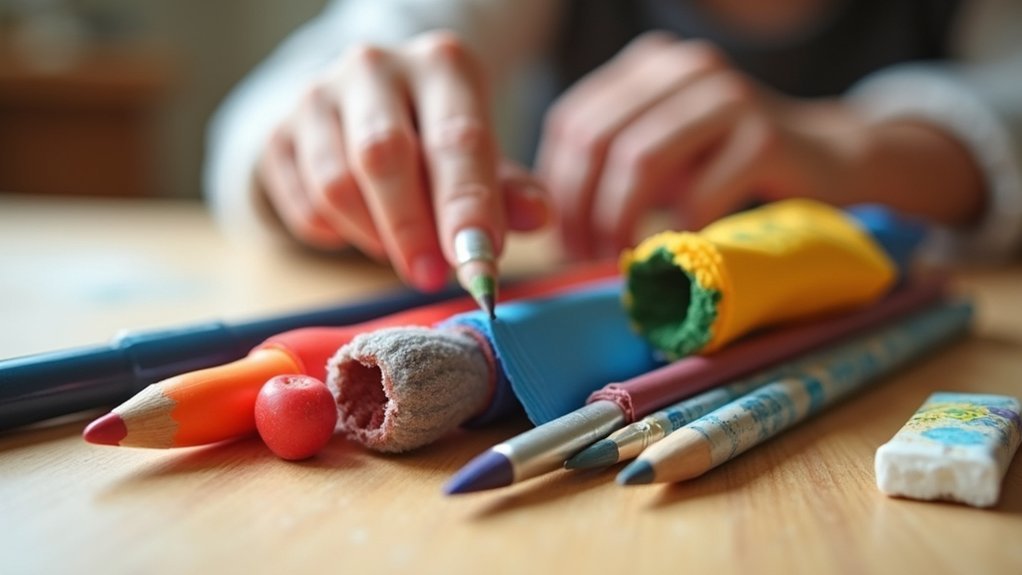
Selecting appropriate art tools when dealing with hand weakness requires careful consideration of your specific condition and limitations. Focus on ergonomically designed tools that fit comfortably in your hand to reduce strain while improving grip strength.
Consider tools with customizable features like interchangeable grips that can adapt to your changing needs. The weight and balance of your tools matter—properly balanced items reduce fatigue during extended use. Materials with varied textures can enhance sensory feedback and dexterity. Incorporating activities with art tools that involve pinching, pulling, and pushing can significantly improve hand strength development while making therapy more enjoyable.
For beginners, start with drawing implements that require precise movements to build finger strength gradually. As you progress, explore sculpting materials that offer resistance training for your hands.
Remember that portable tools allow you to practice strengthening exercises consistently, regardless of location.
Frequently Asked Questions
How Long Before I See Improvement in Hand Strength From Art Therapy?
You’ll likely notice improvements in your hand strength after four weeks of consistent art therapy. Daily practice for 45 minutes is recommended. The key is maintaining regular engagement for several weeks to achieve sustained results.
Can Children With Hand Weakness Benefit From Therapeutic Art Tools?
Yes, your child with hand weakness can definitely benefit from therapeutic art tools. They’ll improve fine motor skills, build strength, and boost confidence while expressing themselves creatively – all within a supportive, enjoyable therapeutic environment.
Are Certain Art Forms More Effective for Specific Hand Conditions?
Yes, specific art forms target different hand issues: clay work benefits arthritis, painting helps with neurological weakness, origami addresses dexterity deficits, and collage supports gross motor skills requiring less fine control.
Will Insurance Cover Art Therapy for Hand Rehabilitation?
Insurance coverage for art therapy in hand rehabilitation varies widely. You’ll need to check your specific plan, as coverage depends on your provider, state regulations, and whether your therapist has proper licensing and certification.
Can Digital Art Provide Similar Hand-Strengthening Benefits as Traditional Methods?
Digital art provides different hand-strengthening benefits than traditional methods. You’ll develop some fine motor skills, but you won’t get the same resistance training that clay, paintbrushes, and other physical materials offer for building hand strength.
In Summary
You’ve discovered that art isn’t just about expression—it’s a powerful therapy for your hands. By choosing the right tools and adapting materials, you’re actually rewiring your brain while strengthening your grip. Remember, every brushstroke, sketch, or clay pinch builds capability that extends beyond the canvas. Whether you’re recovering from injury or managing chronic weakness, your artistic journey can transform limitation into newfound strength and confidence.

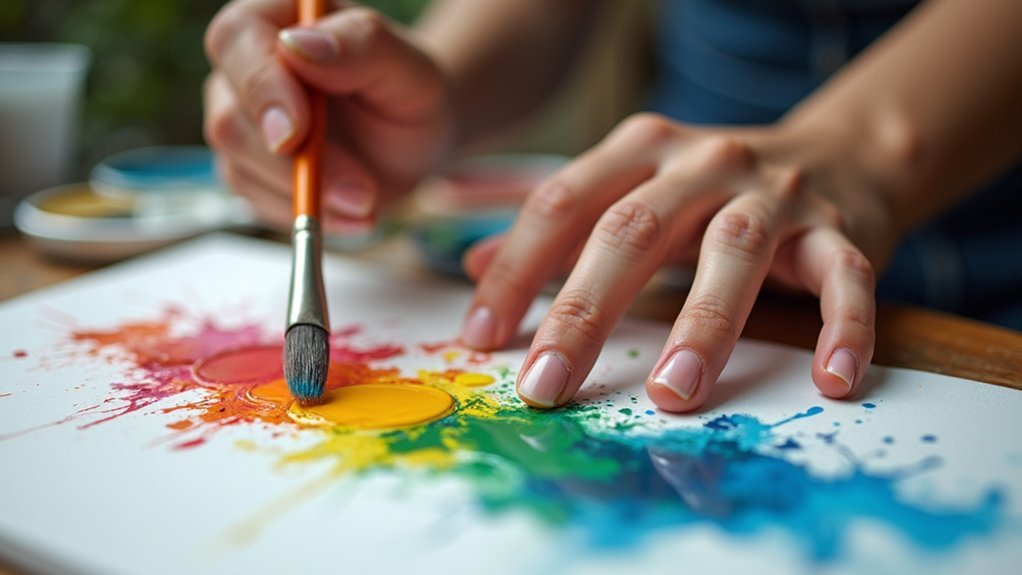



Leave a Reply